| Pages:
1
2
3
4 |
grndpndr
National Hazard
   
Posts: 508
Registered: 9-7-2006
Member Is Offline
Mood: No Mood
|
|
@ Vulture,In the USA 'lax' is a euphemism among gun control advocates/other control freaks for NEEDING MORE of.
Lax, syn for negligent, Websters
As far as NC/DBSP in combination with other sensitive energetics that has been suggested in many posts as a plastic etc etc.ETN/MHN IIRC was
specifically mentioned.No offense.
[Edited on 6-2-2011 by grndpndr]
[Edited on 6-2-2011 by grndpndr]
[Edited on 6-2-2011 by grndpndr]
[Edited on 6-2-2011 by grndpndr]
|
|
|
DNA
Hazard to Others
  
Posts: 191
Registered: 11-6-2003
Location: @moon
Member Is Offline
Mood: Experimenting
|
|
@ quicksilver,
What kind of tubing would you advice then, and why would there be a problem of shockwave propagation through the tube when it is made of polyvinyl?
Would you also think this would be the case when the tube is filled with NG?
|
|
|
quicksilver
International Hazard
    
Posts: 1820
Registered: 7-9-2005
Location: Inches from the keyboard....
Member Is Offline
Mood: ~-=SWINGS=-~
|
|
Well, here is the challenge (IMO).
It would have to be strong enough to retain the energetic material, yet pliable enough to "shatter" & therefore transmit the energy of the cap (or
primary, etc).
We know that over a century ago lead tubing was perhaps the 1st sheathing for the concept of a "det-cord". It had certain physics elements in that it
could be readily shattered and complete the "train" of energy, yet it was pliable enough to bend from area to area, thus allowing multiple near
simultaneous work to be accomplished.
Fabric would certainly work with something like tar to waterproof the containment. If we examine commercial products they use "layers", yet keep them
damn thin. It's not an easy question to answer because we would be re-inventing the wheel.
It would need to be thin, yet very strong. It would need to be waterproof yet not "kink" and open from such abuse.
Quite frankly I can't think of a reasonable substitute than the commercial product. Industry designed most all packaging from cord to sheet to
plastiques in a VERY special way to preform under a variety of conditions. A GREAT deal of R&D went into these items.
The liquid format would not be too promising as it would not be able to be cut and violent kinking or impact may lead to a tragedy. As an example: a
true commercial plastique is not simply a clay-like blob of energetic. It is waterproof, it can stick to surfaces, it can retain shape and become a
shaped charge and it can resist temp changes over a wide range; nor would it crumble or flake. ALL commercial products are not simply "look-a-likes"
of what we would expect an item to accomplish: there is ENORMOUS amounts of thinking and experimenting that make them so applicable to a great variety
of applications.
Quote: Originally posted by DNA  | @ quicksilver,
What kind of tubing would you advice then, and why would there be a problem of shockwave propagation through the tube when it is made of polyvinyl?
Would you also think this would be the case when the tube is filled with NG? |
[Edited on 7-2-2011 by quicksilver]
|
|
|
grndpndr
National Hazard
   
Posts: 508
Registered: 9-7-2006
Member Is Offline
Mood: No Mood
|
|
I ran into a link name CannonFuse.Whats of interest is it has a tutorial for making simple blackmatch and then quickmatch using BP/dextrin/cotton
string.What caught my attention is the simplicity with which the detrinated BP slurry was incorporated into the cotton string and also its
consistency.Also the quickmatch deflagrated @close to 500fps w/BP.
Use the same methods as the blackmatch with a different energetic and that may be something of note.
The blackmatch or fuse string is made of 1/16in COTTON string.A mixture of 10gr dextrin and 50gr BP/ water is made into the consistency of thin
ketchup inside a plastic bowel with a lid.
The lid is removed and a 1/8 hole drilled in the lid, exactly 1/8 w/o any burrs to interferre with the string coating.Metal might be superior?
3ft of the cotton string is cut and rolled into a loop submerged in the BP slurry until soaked.The end of the string is then threaded thru the lids
hole and the lid reattached.The string is then simply pulled out of the container carefully removing excess BP slurry giving a certain amount of
consistency.The string is then hung up to dry.Alone this makes blackmatch when dry.When a tubing is covering the blackmatch the propogation is
encouraged to nearly 500FPS due to pressure -heat.
It seems to me using longer lengths of string/larger containers
along with a different energetic/dextrin.Maybe ETN,TNP/detrin or a liquid made w/acetone TNP.Or Ethanol/ETN soaking the string-drying and covered by a
slightly larger tubing say 3/16 this might work.Ill leave it to those more knowledgable but would a liquid HE be possible.Isopropyl nitrite/nitrate?
Depending on energetic a det of some type size would be needed im assuming. 1/16-string OD .0625, 1/8-string, .125,
3/16 ID tubing, .1875Adequate room that bothe a copper wire winding and an air assist should easily pull the string into the tubing.Max length would
be a matter of trial and error.Although Id be suprised if minimally 30-100ft wasnt a doable deal.
Thoughts, criticism,advice? all welcome!
In any event the string even loaded would be less than.125 OD.
The tubing being 3/16 ID should have an ID of .19 using the thin copper wire from motor windings I would think the wire could be attached to the
string and partially pulled thru the tube assisted by air pressure. Just a thought.
[Edited on 9-2-2011 by grndpndr]
|
|
|
Bert
Super Administrator
        
Posts: 2821
Registered: 12-3-2004
Member Is Offline
Mood: " I think we are all going to die. I think that love is an illusion. We are flawed, my darling".
|
|
Main issue I would see is a dextrin bound composition cracks and breaks off the string with handling. Inside a paper match "pipe" the hot gas
expanding down the pipe bridges any bare areas. A bare area might stop a detonation propagating-
Perhaps make your pseudo black match, then after drying pull it through a bath of something like thinned down vinyl tool handle coating compound to
produce a waterproof flexible outer skin. Then even if the coating did crack up, it would stay in place.
BTW, 500fps would be an unusually high speed for paper jacketed match in my experience. It can go damn near speed of sound in a metal or heavy plastic
tube that doesn't burst or burn through though.
Rapopart’s Rules for critical commentary:
1. Attempt to re-express your target’s position so clearly, vividly and fairly that your target says: “Thanks, I wish I’d thought of putting it
that way.”
2. List any points of agreement (especially if they are not matters of general or widespread agreement).
3. Mention anything you have learned from your target.
4. Only then are you permitted to say so much as a word of rebuttal or criticism.
Anatol Rapoport was a Russian-born American mathematical psychologist (1911-2007).
|
|
|
grndpndr
National Hazard
   
Posts: 508
Registered: 9-7-2006
Member Is Offline
Mood: No Mood
|
|
Im sure the coating would tend to flake off but the tube should eliminate direct contact with the energetic soaked string .Only the exterior less
flexible tubing would be subject to direct handling which should be less flexible than the string.Hopefully!
Maybe this is a round about method using a solid crystaline substance.Maybe if the energetic was completely in solution the entire string fibers could
be impregnated with the energetic.I would think the grains would be much more difficult to dislodge
from the interior spaces of the string fibers.Cant forget a string soaked in a liquid HE either.With the excess liquid removed and placed inside a
nylon/other approx 3/16 ID tubing It would have a limited life span but could be useful.
In the end however ya cant beat the simplicity of a simple fused or electric initiator.The tech for det cord or a shocktube system might be to much
to duplicate in the garage.
Ultimately potential problems will be found regardless so i would think the only method that would be recognized is the one thats proved successful
consistently, should anyone care to pursue the quest.Im gonna be busy unfortunately.
[Edited on 10-2-2011 by grndpndr]
|
|
|
Northhunt
Harmless

Posts: 1
Registered: 30-3-2011
Member Is Offline
Mood: No Mood
|
|
Dont know if this have been mentioned before; If so delete this post ASAP.
I have thought about mixing ETN with for example water, NM, NG etc. Put your slurry in a cup, place your tubing in the cup, attach a syringe at the
other end, and suck the slurry through your tubing. If water is used-dry, and use as shocktube.
|
|
|
Bot0nist
International Hazard
    
Posts: 1559
Registered: 15-2-2011
Location: Right behind you.
Member Is Offline
Mood: Streching my cotyledons.
|
|
If using water and allowing it to dry I think the energetic material would be loosely dispersed inside the tubing which could cause propagation
issues. If using a liquid explosive then you still have the difficulty of a tube filled with liquid. Unless maybe one could draw a thick, non volatile
gel into the tube without a lot of air pockets forming. Maybe that could be tried.
|
|
|
holmes1880
dushbag
Posts: 194
Registered: 13-12-2010
Location: http://highexplosivesforum.forumotion.com/
Member Is Offline
Mood: Egregious
|
|
@Bot0nist
Pumping a slurry into a tube would require serious suction/pressure because the resistance would be exponentially increasing with column length.
I like Northhunt's proposal and actually tried mixing ETN/NM at 1:2.5 ratio. The NM dissolved ETN, turning slightly yellow, with only a small
particles freefloating inside. I was able to use a syringe to quite easily inject it into a small section of the test tube. It is very convenient.
I calculated that 1:2.5 ETN/NM ratio requires 6.5 grams/1 meter @ 4mm tube ID. That may be a little steep in terms of ETN demands. Thus, perhaps
increasing that ratio to 1:5 may be desirable, as long as it is still sensitive to a standard cap and can be initiated via cord overlap. 1:5 ratio,
would only require about 3g/meter, which is very attractive and safer.
How does that sound?
|
|
|
holmes1880
dushbag
Posts: 194
Registered: 13-12-2010
Location: http://highexplosivesforum.forumotion.com/
Member Is Offline
Mood: Egregious
|
|
^^^^
Scratch that. It won't work, not in a 4mm vinyl tube as shown per my test. I actually have a hard time penetrating the vinyl tube with a liquid in it.
It looks like it just flexes from the impact, with some minor shredding.
|
|
|
Hennig Brand
International Hazard
    
Posts: 1284
Registered: 7-6-2009
Member Is Offline
Mood: No Mood
|
|
I have a simple idea for making homemade detcord which I don't think has been proposed here before (or at least not in this thread).
The tubing must be carefully taped to a piece of dowel so that it is kept reasonably straight. If it is not straight the plunger dowel/loading dowel
will be very hard or impossible to push into the tube reducing loading efficiency. Obviously the dowel diameter needs to be a little smaller than the
inside diameter of the tube as well. A notch is cut out of the tube near the end. A small hopper (the bottom open end being slightly larger than the
notch) can be fashioned out of cardboard and attached over the notch hole. It is glued in place with hot melt glue.
So, the process is very simple. A little blob of hot melt glue is used to plug the bottom end of tube. Tap the hopper a little, then push the charge
into place with the loading dowel. Remove the loading dowel and repeat. The hopper needs a spoonful of ETN (or whatever your HE of choice is) added
every now and then. I could load a meter of this stuff in 15 minutes if everything was working properly.
It is sort of like a semi-auto firearm. I tried it without the hopper and it took forever. The hopper is disposable, it is simply cut off after the
cord is full. A more permanent setup could most likely be made based on the same idea.
A vibrator motor on the hopper would probably be a very good addition, greatly increasing loading efficiency further. With a vibrator in place it
would be non stop stroking
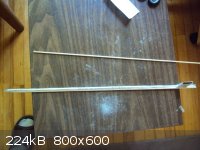 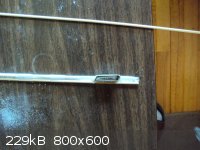 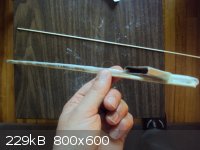 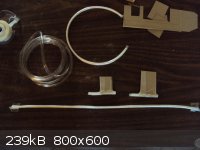
[Edited on 11-7-2011 by Hennig Brand]
|
|
|
Hennig Brand
International Hazard
    
Posts: 1284
Registered: 7-6-2009
Member Is Offline
Mood: No Mood
|
|
Here are a few pictures of my detcord. The first shows about 3 meters in a coil, two of the three are in meter long lengths and two are in half meter
lengths. The explosive filler is ETN. The cord used on the tree was about 0.4 meters long. The detonator was 1g PETN, 0.3g lead azide, with a little
lead picrate on top. The alder tree was approx. 6cm in diameter, green and healthy. Some tape was used just to keep everything tight and in place, it
also provided a bit of confinement I guess.
After some measurements and figuring, I found that my det cord was only 9grams per meter instead of the desired 10g/m. I noticed my density is a
little low. The main reason I am persuing this is for setting multiple charges off simultaneously. It sure is a lot of fun just to play with though.
The meter long pieces took me longer than 15 minutes to load (more like 30 minutes), but I can see how it could easily be done in 15 minutes or less
with the right setup. Crystal structure of the explosive, as well as having a nice straight smooth loading dowel, plays a huge role in determining how
easy the cord is to load. A vibrator motor on the hopper would also be nice, as a lot of time is wasted tapping the hopper.
Pictures are mostly just for entertainment purposes.
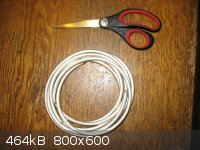 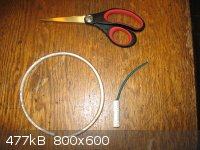 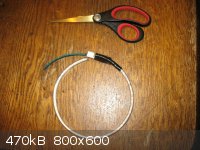  
[Edited on 2-8-2011 by Hennig Brand]
|
|
|
holmes1880
dushbag
Posts: 194
Registered: 13-12-2010
Location: http://highexplosivesforum.forumotion.com/
Member Is Offline
Mood: Egregious
|
|
Activated ammonal 95/5 can detonate in 6mm vinyl tubing. However, it is best to use 10mm, because with 6mm there can be not enough contact between
ammonal powder in areas where powdered AN is a little bit coarse.
If you have a good blender, this shouldn't be too much of an issue.
[Edited on 8-2-2011 by Polverone]
The time is not enough.
|
|
|
Polverone
Now celebrating 21 years of madness
|
Thread Split
2-8-2011 at 13:30 |
Hennig Brand
International Hazard
    
Posts: 1284
Registered: 7-6-2009
Member Is Offline
Mood: No Mood
|
|
I guess the title of this thread is called, "A more durable improvised detonating cord". Here is something that relates to the title. I saw a show on
The Discovery Channel a while back, and it talked about detcord (the show was called "The Detonators" I think). The outside of the commercial 50
grain(~10.6g/m) detonating cord they showed was truly like a synthetic cord of some kind, they even went as far as to say that they could hang a horse
by it.
The improvised detcord from vinyl tubing is nowhere near as durable as the commercial counterpart (in particular no tensile strength at all), however
aside from that I believe it does have most of the same useful properties. The tough outer coating on the commercial variety must have a lot more to
do with safety. I mean, do we really need detcord that doubles as a tow rope for normal use?
I think the stuff from vinyl tubing will work great for setting charges off simultaneously. I need to find a mean stump with several big roots to
experiment on.
edit:
It seems that the boys on the Discovery channel probably exaggerated a bit. In the wiki page on detcord is a link to an information page from Dyno
Nobel. Their 10.8g/m variety (primacord) has a tensile strength of 200 lbs or 90kg (a very small horse!). They must have meant to use the cord doubled
up several times to hang the horse? Maybe the stuff they were using was different, but probably not that much. I feel it was a bad description on
their part since even dental floss could hang a horse if one used enough.
I attached a link to the dynonobel pdf, it has some interesting specs in it.
http://www.dynonobel.com/files/2010/04/Primacord.pdf
[Edited on 3-8-2011 by Hennig Brand]
|
|
|
holmes1880
dushbag
Posts: 194
Registered: 13-12-2010
Location: http://highexplosivesforum.forumotion.com/
Member Is Offline
Mood: Egregious
|
|
We have still to learn how they commercially stuff PETN inside that tubing. Same goes for shock tube- oh, how much time I wasted on trying to
replicate the shocktube. It looks like it is a well kept secret. Vinyl tubing is OK for the amateur use, but ideally the walls need to be a less
flexible tension-wise and thinner. As far as I looked, nothing is available right now on the consumer hardware market.
I also brought up ammonal as an alternative to ETN because in order to make large amounts of the cord, you'd need to open up an ETN factory.
20ft=60grams of ETN. If I recall correctly, it took me 30 minutes to fill up 10ft of 6mm ID ammonal cord. With 1cm ID, it will take probably 10
minutes/20ft and you won't have to make ETN by pound. It is just a more practical solution. With 6mm ID, I had a packing density of 700mg/inch or
roughly 30g/meter. With 10mm ID vinyl, that should be close to 50g/meter. It will be capable to initiate charges tied to it without the need to
double-loop.
P.S. Don't waste trees. They are good for air and covering up the noise.
The time is not enough.
|
|
|
Hennig Brand
International Hazard
    
Posts: 1284
Registered: 7-6-2009
Member Is Offline
Mood: No Mood
|
|
I am pretty sure the explosive filler is inserted and the tubing/cord is put together in a continuous and simultaneous process, it is very much the
same way some fuse is made, I think (different materials of course).
One of the main advantages of detcord is that it packs so much power into such a small convenient package. It is amazing the things you can do with
tiny charges of this powerful stuff. Of course it is not a substitute for full sized charges and cheap bulk explosives for the other applications that
call for less precision and more blunt force.
Ammonal would be cheaper, but TNT is not going to be easier to make for most people, it is also more of a bulk explosive with rather poor performance
incomparison to ETN especially in small diameter charges (detcord). I suppose really large detcord could have its uses, but I don't know if ammonal
would be my first choice.
I sort of like making ETN, I find it very straight forward, cheap and with fairly good storage stability and performance. I like my small powerful
detcord. Detcord is a very expensive product even when made commercially, but it is invaluable for certain applications. The 10g/m variety is supposed
to be quite adequate for detonating most normal explosives, but not the insensitive ones like anfo of course. In the case of insensitive secondaries,
the end of the 5g/m or 10g/m detcord is connected to a compound cap or booster.
I may have jumped the gun a little by saying that vinyl tubing has not much tensile strength. Many links when googled state that clear soft vinyl
tubing has a tensile strength of about 2000psi. So take the total cross sectional area of the tube, minus the cross sectional area of the bore hole in
the tube, multiplied by 2000 psi, gives I think ~52.8 pounds for my 1/4" tubing. Unless there is something I missed vinyl tubing is no slouch in the
tensile strength department. It would stretch like crazy though. The vinyl tubing being packed full of pressed explosive must help it resist
deformation as well, I would think, adding to its strength.
Don't kill trees, yeah a lot of the time I would agree. Those alders are like weeds in the location they are in though. Apparently alders are good at
fixing nitrogen for the soil, they have special nodules in their root system with special nitrogen fixing bacteria that allow them to do this, a few
other plants that I know of do this too. I should put them to work making nitrates for my hobby.
BTW, the ETN in the detcord, in my post above is close to 2 years old. Recrystallized with a little urea, etc.
edit: If using the same density as your 6mm tube, the 10mm tube would be loaded closer to 80g/m I think.
[Edited on 3-8-2011 by Hennig Brand]
|
|
|
Rosco Bodine
Banned
Posts: 6370
Registered: 29-9-2004
Member Is Offline
Mood: analytical
|
|
Whatever is mysterious was probably done by elves 
http://www.youtube.com/watch?v=wKiw9-HLkXU Eternity Road
[Edited on 3-8-2011 by Rosco Bodine]
|
|
|
Hennig Brand
International Hazard
    
Posts: 1284
Registered: 7-6-2009
Member Is Offline
Mood: No Mood
|
|
Very funny
You know it is sort of that mysterious and illusive nature in all of this chemistry stuff that keeps me intrigued though.
I bet Rosco has a few good ideas for detcord
|
|
|
Rosco Bodine
Banned
Posts: 6370
Registered: 29-9-2004
Member Is Offline
Mood: analytical
|
|
Seeing those scissors in the picture .....a solemn warning is in order here......
never, do not not ever use scissors or shears to cut det cord, use a razor knife.
|
|
|
hiperion42
Hazard to Self
 
Posts: 75
Registered: 24-8-2009
Location: european mainland
Member Is Offline
Mood: overwhelmed
|
|
I may be wrong but i think holmes1880 means AN-AL powder aka French ammonal.
[Edited on 8-8-2011 by hiperion42]
.....ejuu....................................................................Ffg..............................g.............
|
|
|
Bot0nist
International Hazard
    
Posts: 1559
Registered: 15-2-2011
Location: Right behind you.
Member Is Offline
Mood: Streching my cotyledons.
|
|
Quote: Originally posted by Rosco Bodine  | Seeing those scissors in the picture .....a solemn warning is in order here......
never, do not not ever use scissors or shears to cut det cord, use a razor knife. |

I would like to reiterate this. I know that this isn't a straw filled with HMTD, so the convenience of using scissors may seem appealing. Know that
the physics involved at the place where the scissor blades meet is not the same as what is experienced when using a straight razor. They are not the
forces that one want's to expose a sensitive secondary explosive like ETN to.
Yes, I know many will attest to ETNs safety and practicality, and god knows that if holmes1880 was still here he would rant and rant about it, but
scissors should be a no no, IMHO.
I like your project BTW. Good idea with the hopper. Works good for small scale, and speeds up a tedious process.
U.T.F.S.E. and learn the joys of autodidacticism!
Don't judge each day only by the harvest you reap, but also by the seeds you sow.
|
|
|
User
Hazard to Others
  
Posts: 339
Registered: 7-11-2008
Location: Earth
Member Is Offline
Mood: Passionate
|
|
When it comes to filling a tube my guess is that a softer material would be easier, something slightly moldable.
Something sprung to mind: see attachment.
This speaks for itself I guess.
I can image this would form some kind of wax/paste that allows possibly easier filling, and it might be easier to achieve higher density.
Cracking my head over a good filling method today.
Might sound very crazy but what about freezing a tube so one can work with a solid object(for the time being).
Or maybe a mantle for it.
The annoying thing about a hose is the flexible part I think.
Just a random throw, dont kill me lol.
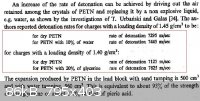
[Edited on 8-8-2011 by User]
What a fine day for chemistry this is.
|
|
|
Hennig Brand
International Hazard
    
Posts: 1284
Registered: 7-6-2009
Member Is Offline
Mood: No Mood
|
|
Scissors, bad choice for prop
For the record I didn't use scissors to cut the finished cord. I stuck the scissors in the picture for scale mostly, kind of like a geologists hammer.
The scissors were handy because I was using them for many other things, like cutting fuse. I never thought about it much, yeah it wasn't such a good
idea putting them in the picture. Actually I haven' t cut any of my finished cords yet, I used them in the size they were made in. To tell the truth,
I didn't like the idea of cutting it at all.
I watched a television show on blasting a couple years ago. In the program they demonstrated what they believed to be the safest method of cutting
detcord and dynamite. They used a wooden cutting board and a sharp knife, I believe it was an exacto type knife or box-cutter.
I think the loading process is fairly safe, but not entirely without risk. How much risk I am not exactly sure, so be careful. Someone who knows more
than me mentioned that ETN' s friction sensitivity could be enough to make the loading process quite risky. I think I may try and quantify this risk a
little more in the near future with some tests. The tube and the wooden rod are fairly soft, but I guess the danger could be more than I realize.
BTW, I cut down an aspen tree a couple days ago which was a fair bit larger in diameter than the alder in the previous picture, a piece of detcord a
little less than a meter long was used. This stuff is quite a bit of fun.
[Edited on 9-8-2011 by Hennig Brand]
|
|
|
AndersHoveland
Hazard to Other Members, due to repeated speculation and posting of untested highly dangerous procedures!
    
Posts: 1986
Registered: 2-3-2011
Member Is Offline
Mood: No Mood
|
|
The methyl ester of picric acid melts at only 68.4 °C.
http://en.wikipedia.org/wiki/Trinitroanisole
Would 2,4,6-trinitrophenoxy-ethanol nitrate (TNPEN) be potentially useful in det- cord? The compound has a melting point of 104.5°C, so it should be
possible to safely melt it using a magnesium sulfate (epsom salt) boiling hot water bath. The compound is somewhat less sensitive than PETN.
Basically, phenol and ethylene glycol are mixed in the proper ratio, then the ester is formed by slowly adding concentrated sulfuric acid. The
reaction is allowed to cool,
then a cold mixture of nitric and sulfuric acids are added (using an ice bath to prevent run-away reaction) to perform the nitration.
http://web.mit.edu/semenko/Public/Military%20Manuals/RogueSc...
(NO2)3C6H2-O-CH2-CH2-ONO2
[Edited on 9-8-2011 by AndersHoveland]
I'm not saying let's go kill all the stupid people...I'm just saying lets remove all the warning labels and let the problem sort itself out.
|
|
|
Hennig Brand
International Hazard
    
Posts: 1284
Registered: 7-6-2009
Member Is Offline
Mood: No Mood
|
|
@Anders
I assume you mean to melt it then put it into a tube somehow. Sounds interesting, but there are some other problems this brings up. The obvious one
is, what is the tube going to be made of? It can't melt. Vinyl tubing goes into a sloppy mess at way less than boiling water temperature, but there
are quite a few other materials to choose from. I don' t know how much of a problem shrinkage and cracking would be, but it could be an issue. How in
the heck to keep the molten explosive from setting up solid before getting it into position in the tube? I guess they did use TNT in detcord so it can
be done, but it was a bit different thing than PETN detcord though, I think. The idea of using a low melting point solid explosive is neat.
@User
You mentioned a mantle for the tubing. I assume that is like a jig of some sort (not familiar with that use of the word mantle). I like the idea. I
have been thinking along those lines too. It would beat taping the tubing to a piece of dowel to hold it straight every time. A permanent hopper could
be fitted to the jig/mantle also.
This could be made out of wood very easily. A router and router table could be used to cut half cylinder channels, the same diameter as your detcord,
out of 2 identical pieces of wood. To get 2 identical pieces just carefully rip a suitable piece of wood with the right dimentions in half first. I
would also suggest a good piece of hardwood if you can get it. Once you have the half cylinder cut out of both sides, put a rod or something the same
size as your detcord tube in the channel and clamp the two pieces together with screw clamps. Drill through from side to side (below the channel, not
through it, or above it) so short pieces of ready rod can be put through. Wing nuts and washers can go on the ready rod ends, for convenient
tightening and loosening. Plane down what will be the top side of the wooden detcord jig until you have enough of the channel showing to make a
viewing window through to the tubing/ through to the loading progress. Don' t plane off too much, or you could lose the function of the jig. I would
plane down just until the top of the channel becomes visible, then use a chisel to widen it out a little.
A more permanent hopper to go with the jig could be made as well. I like it!
Here is a strange idea. Have a sealed powder funnel capable of being pressurized. Get a tube that is elastic enough that it can be put under pressure
and stretch well without deforming it permanently. Seal one end of the tube well, somehow. Pressurize the sealed funnel and tubing so the tubing
swells. Turn on the vibrating funnel (did I mention it vibrates?), so the ETN or PETN fills the tube (there could be some technical difficulties with
filling, but I think it could be made to work). Once full, release the pressure and the tube shrinks compressing the explosive powder, to what you
hope is a decent density. How' s that for a strange solution?
[Edited on 10-8-2011 by Hennig Brand]
|
|
|
| Pages:
1
2
3
4 |